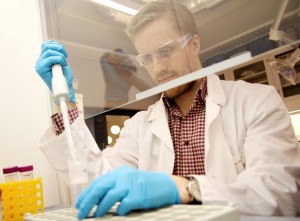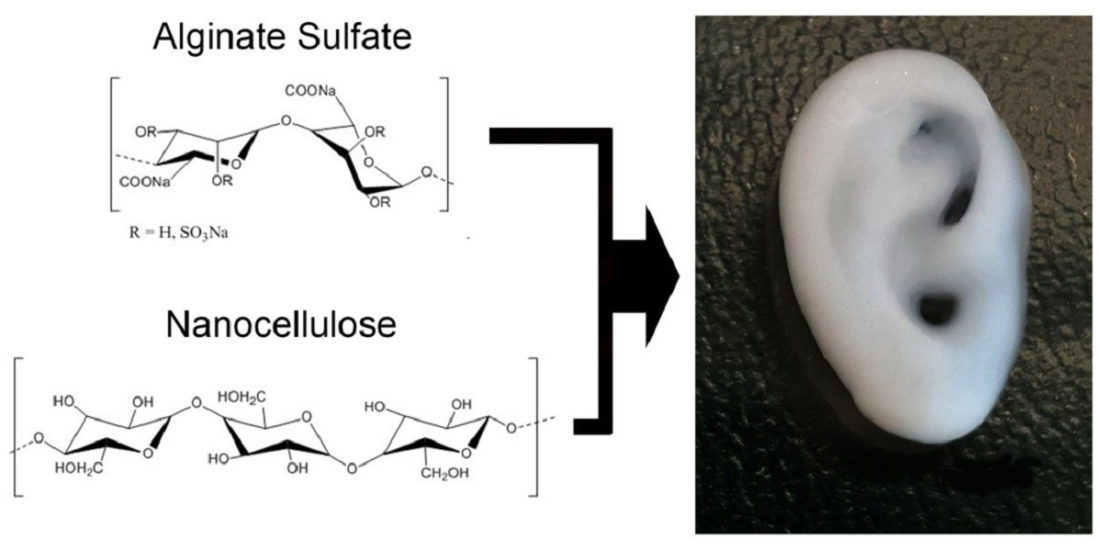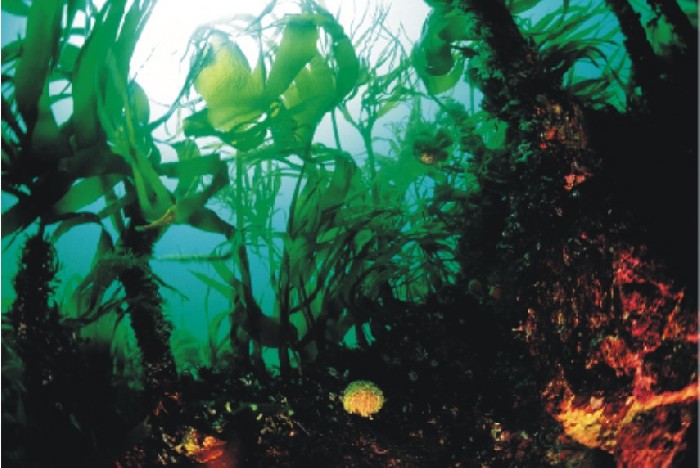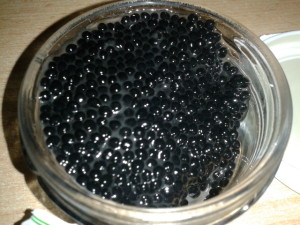New ears from algae
Scientists are using alginate from seaweed to try to get cells to form new body parts.
ALGINATES: Scientists have found a way to create a good growing environment for cells to regenerate outside the body. The aim is to be able to create new tissues such as skin, cartilage, tendons and even organs, like the nose and kidney.
Imagine that you’ve worn down most of the cartilage in your knees, making it painful to move. Healthy cartilage cells from another part of your body or from another person can make new cartilage for your knees.
The best conditions for these cells to reproduce are in your own body, but this isn’t possible yet. A major challenge is thus to create a growth environment outside the body that resembles the natural environment closely enough so that cells can divide and form functional tissue.
Alginate can help create this environment. NTNU and SINTEF scientists are working to understand alginates’ properties and structure for use in regenerative medicine, the field of medicine that helps the body rebuild damaged and destroyed tissue.
“We also lack enough organ donors, and in the future we hope to be able to grow cells and tissues to create new organs. To avoid problems with incompatibility we would primarily collect cells from the patient, and then cultivate the new tissue outside the body,” says Øystein Arlov.
In his PhD in Biotechnology at NTNU, Arlov has researched how we can use alginate to create good growth opportunities for cells.
- You might also like: Developing biological micro-factories with LED
Alginate has loads of uses
Alginate is extracted from seaweed, and in Norway from the kelp Laminaria hyperborea in particular. Alginate is the major component of cell walls in seaweed.
Today alginates are used about 600 different ways. They have the ability to thicken, stabilize, and form gels and capsules and are therefore widely used in the food industry as a thickener and binder in products like ice cream, jams, desserts, dressings and mayonnaise.
Alginates are also increasingly used in the medical industry. The multiple ways that alginates can be applied, and the ability to constantly give them new characteristics, have generated strong interest in alginate research.
Enzymes can change alginate properties
Alginate is a so-called polysaccharide compound, a polymer of sugar molecules. Polymers are long molecules consisting of many repeating subunits. Starch, glycogen and cellulose are examples of common polysaccharides, or sugar chains.
The many different properties of alginate stem from the polysaccharide structure. This structure can be modified using a special group of enzymes.
Treating alginate with enzymes restructures the alginate and gives it new properties. In other words, the enzymes determine which properties the alginates get.
- You might also like: Skeleton greenhouse
Creates scaffolding for growing cells
Cultivating new cells or tissue requires a scaffold for cells to grow on.
To grow new cells and new tissue, we primarily want to use cells from the person who needs e.g. new cartilage, and cultivate the tissue outside the body. This requires a three-dimensional framework for cultivating the cells. Without this framework to grow onto, the cells die.
“We’re working to develop new materials and scaffolding structures to be able to grow cells and living tissue outside the body,” says Arlov, who is now a researcher at SINTEF Biotechnology.
Constant cell renewal

“We are working to develop new materials and scaffolding structures to be able to grow cells and living tissue outside the body,” says Øystein Arlov at SINTEF Biotechnology. Photo: Per Henning / NTNU
Cells are constantly busy producing new cells inside the body. And inside the body, cells build their own scaffolding that creates good growing conditions. Scaffolds are composed mainly of structural proteins such as collagen and glycosaminoglycans (GAGs), which have complex biological functions. GAGs are long chains of sugars found in all the body’s tissues.
These GAG chains play a major role in the growth and maintenance of cell tissue. The chains are important components for the development of all types of tissues including the cornea, cartilage, tendons, skin and connective tissue.
Researchers from NTNU and SINTEF are using alginate to create similar scaffolding outside the body. The problem with alginate is that it doesn’t interact particularly well with cells. The cells survive, but alginate scaffolding does not promote growth in the same way that GAG scaffolds do.
The best of both worlds
The researchers say it would be ideal if they could recreate a developmental environment outside the body similar to GAGs for the cells to grow in. But GAGs are part of a larger network and depend on various constituents within the body, like collagen and glycoproteins, to form the architectural framework.
Alginate, however, has the advantage that it can form a gel and framework on its own, outside the body and under very mild conditions.
Arlov said, “We wanted to retain the beneficial properties of alginate while simultaneously introducing GAG characteristics to create better conditions for cell growth. We wanted to draw out the best of both worlds. GAGs have a variable and complicated structure, but they offer good growing conditions. Alginate, on the other hand, has a predictable and adjustable structure, but doesn’t provide as good growing conditions.”
He has managed to achieve this proper enhancement by introducing special structural properties from GAGs to alginate.
Necessary receptors
One characteristic of the molecular structure of GAGs is that they have a high number of sulfate groups. This creates a negative charge in the molecule, which allows it to bind to proteins with a positive surface. GAGs can thus act as recipients of chemical signals from the surroundings, signals that are forwarded to the cells.
“If this connection is missing, most types of cells stop growing,” says Arlov.
Alginate has no sulfate groups bound onto it, so it doesn’t have the necessary receptivity found in GAGs.
“Therefore, I chemically modified the alginate, and introduced sulfate groups that provide more negative charge to the alginate. We do this to obtain a structure that resembles GAGs more,” says Arlov.
More specifically, he says, “sulfated alginate can be seen as a parallel to heparin and heparan sulfate, which are related GAGs. Heparin is the most negatively charged sugar molecule we have in our bodies and it binds strongly to proteins with a positive surface, which many proteins have.”
In this way, the sulfates contribute to creating the important receptors that are found in GAGs.
“We want the cells to divide and spread, but we also want them to retain their identity. If you remove some cells from the body and allow them to grow outside the body, they may develop differently than when they were inside the body. But by using the modified alginate, the cells retain their identity,” says Arlov.
The article continues below the illustration.
Helps the body in transplantation
“Our sulfated alginates also affect the immune system, just like GAGs do. They can partly dampen the immune response, which may be useful in transplantation of cells encapsulated in alginate, for example,” says Arlov.
“Now,” he continues, “we’ve laid the groundwork and developed a model from which we can build good scaffolding for cells to grow in. Unlike many commercially available materials, the structure of the sulfated alginate can be fine-tuned and adapted to different cell types depending on what we wants to cultivate: skin, cartilage, an ear or maybe a new kidney down the road? Now we’re ready to test these substances in different contexts.”
Much of the cell regeneration research has been conducted in collaboration with ETH Zurich and the research group Cartilage Engineering and Regeneration Laboratory.
Scientific publications:
Article on how sulfated alginates suppress the immune response. Published in Acta Biomaterialia, 2016 Jun 11. pii: S1742-7061(16)30292-6. doi: 10.1016/j.actbio.2016.06.015.
https://www.sciencedirect.com/science/article/pii/S1742706116302926
Article about culturing cartilage tissue. Published in Advanced Functional Materials, Öztürk, E., Arlov, Ø., Aksel, S., Li, L., Ornitz, D. M., Skjåk-Bræk, G. and Zenobi-Wong, M. (2016), Sulfated Hydrogel Matrices Direct Mitogenicity and Maintenance of Chondrocyte Phenotype through Activation of FGF Signaling. Adv. Funct. Mater., 26: 3649–3662. doi:10.1002/adfm.201600092.
https://onlinelibrary.wiley.com/doi/10.1002/adfm.201600092/full.






